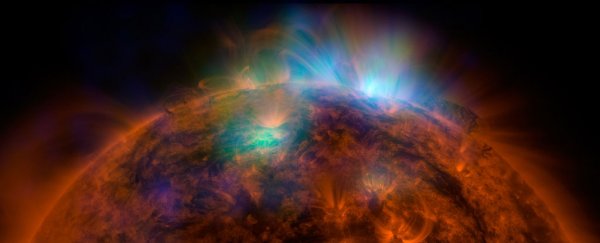A NASA-funded study has solved a longstanding mystery over the origin of X-rays that permeate space in our Solar System, but in doing so, it's also discovered an entire group of high-energy X-rays that can't be explained.
The research comes from a new analysis of data recorded by NASA's DXL rocket mission, which took flight in 2012 to settle the question of what creates these low-energy X-ray emissions – called the diffuse soft X-ray background – in our corner of the galaxy.
At the time, there were two central hypotheses. X-ray emissions were known to come from solar wind, but scientists also thought they might originate from what's called the Local Hot Bubble – a theorised region of hot gas that envelops our Solar System. But which was correct?
"We show that the X-ray contribution from the solar wind charge exchange is about 40 percent in the galactic plane, and even less elsewhere," says astrophysicist Massimiliano Galeazzi from the University of Miami. "So the rest of the X-rays must come from the Local Hot Bubble, proving that it exists."
But while the findings of the recent DXL (Diffuse X-ray emission from the Local galaxy) mission may have settled an old debate on the origin of these space X-rays – which were only themselves detected in the 1960s – the data have now opened up another cosmic mystery.
When DXL took off from White Sands Missile Range in New Mexico back in 2012, it was only a short flight. Carried aboard a NASA Black Brant IX 'sounding rocket' – a term for short sub-orbital research missions – the DXL payload took its readings of X-ray emissions in just 5 minutes above Earth's atmosphere, before parachuting back to the surface.
But that short window was long enough for DXL's instruments to pick up something the scientists weren't expecting: evidence of high-energy X-rays that the researchers say couldn't possibly originate from the solar wind or the Local Hot Bubble.
"At higher energies, [the solar wind and the Local Hot Bubble] contribute less than a quarter of the X-ray emission," says one of the researchers, Youaraj Uprety from Middle Tennessee State University. "So there's an unknown source of X-rays in this energy range."
While nobody knows where these high-energy X-rays are coming from, the researchers are sure they can't be related to solar wind or the Local Hot Bubble.
After scientists became aware of space X-rays in the 1960s, they knew the emissions had to be produced locally, as the levels of neutral gas in our Solar System meant X-rays would be absorbed if they emanated from a distant source elsewhere in the galaxy.
The first prevailing hypothesis was that the Local Hot Bubble – a huge peanut-shaped bubble of hot ionised gas about 300 light- years long, inside which our Solar System exists – was responsible.
"We think that around 10 million years ago, a supernova exploded and ionised the gas of the Local Hot Bubble," says Galeazzi. "But one supernova wouldn't be enough to create such a large cavity and reach these temperatures – so it was probably two or three supernova over time, one inside the other."
More recently, scientists have discovered that diffuse X-rays could also be produced inside the Solar System, which gave rise to the hypothesis that solar wind – specifically something called solar wind charge exchange (SWCX) – was creating them.
When solar wind interacts with pockets of neutral gas in space, it can pick up electrons from the neutral particles. But once the electrons settle back into a stable state, they lose energy, in the form of X-ray emissions.
Thanks to the DXL mission, we now know that both of these phenomena are responsible for producing the diffuse soft X-ray background in our Solar System. That's a win in itself, especially since it tells us more about the nature of the Local Hot Bubble, which scientists still have little understanding of.
"Identifying the X-ray contribution of the Local Hot Bubble is important for understanding the structure surrounding our Solar System," says Uprety. "It helps us build better models of the interstellar material in our solar neighbourhood."
But as for those unknown high-energy X-rays? Nobody knows for sure where they come from.
The researchers say solar wind generates less than a quarter of X-ray emissions at higher energy levels, and it doesn't look like the Local Hot Bubble is responsible either.
"The temperature of the Local Hot Bubble is not high enough to produce X-rays in this energy range," says Uprety. "So we're left with an open question on the source of these X-rays."
The good news is that DXL's successor – DXL–2 – took to the skies in December last year, and when Galeazzi's team has a chance to investigate the new data, we might just be able to solve this latest mystery too.
Watch this space.
The findings are reported in The Astrophysical Journal.
